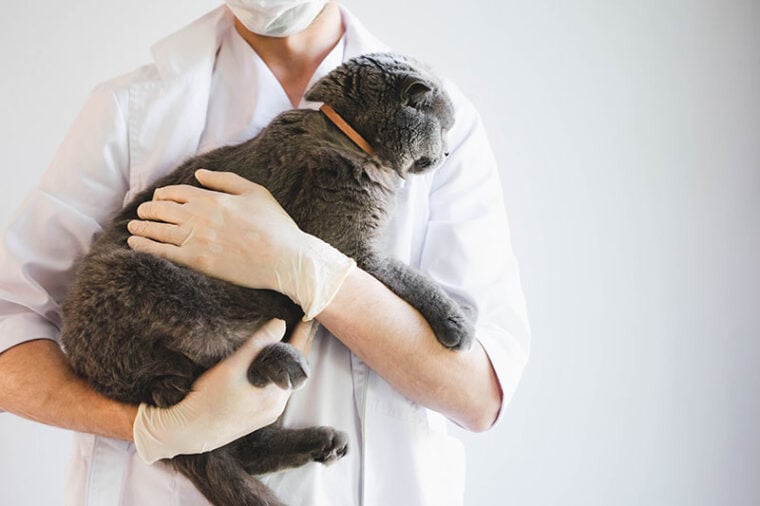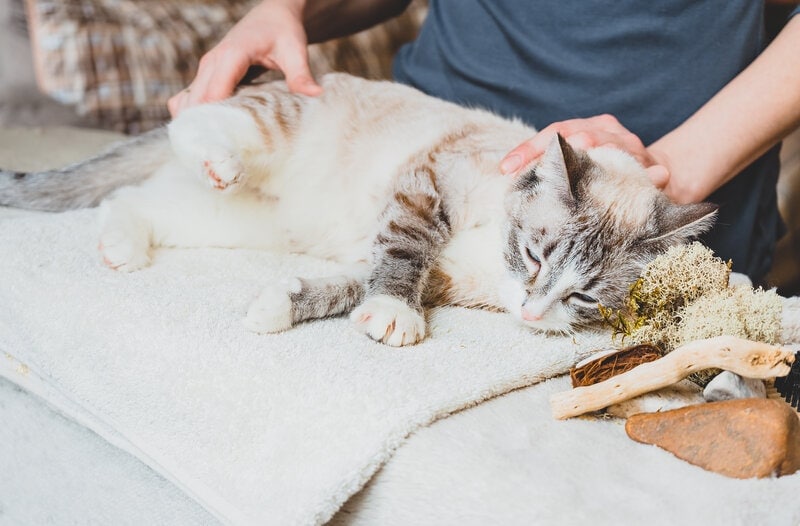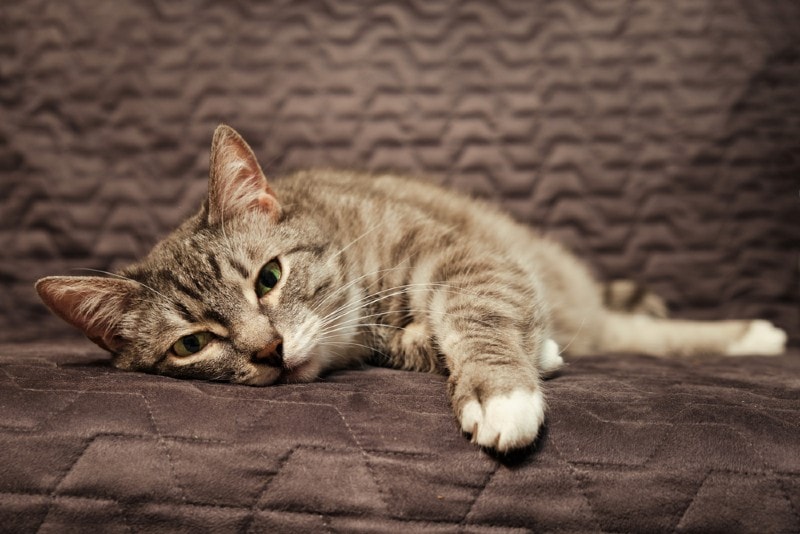
While “luxating patella” may sound like a funny phrase, it’s actually a medical term that means the kneecap, (or patella) is moving out of place (or luxating). This disease occurs fairly often in dogs, but a lesser-known fact is that, while rarer, it can also occur in cats. Luxating patellas can be a potential cause of rear leg lameness.
In this article, we’ll delve a little deeper into the lesser-known world of patellar luxation in cats.
What Are Luxating Patellas?
To understand more about this disease process, a little anatomy background on the stifle joint (knee area) may be helpful. The knee (stifle joint) houses the end of the femur (thigh) bone that connects to the top of the tibia (shin bone) and fibula bones below it. At the end of the femur bone is the trochlear groove, which in normal anatomy, cradles the patellar bone (kneecap). If the patella is already located outside of or moves outside of the trochlear groove, a luxating patella has occurred.
The patella bone itself is small and triangular in shape. It covers where the front of the femur and tibia move with each other at the knee joint. Its purpose is to ultimately allow for the bending and movement of the knee but also protection of this joint.
A luxating patella will usually be described as either medial or lateral. A medial luxating patella (MPL) means that the kneecap moves inwards (medially) from the trochlear groove towards the midline of the cat’s body compared to the normal position. A lateral luxating patella (LPL) means the kneecap moves to the outside (laterally) of the trochlear groove compared to normal. A medial luxating patella is more common than lateral in cats. A luxating patella can occur in one or both rear legs, but about 80% of cats with this disease are affected in both rear legs.

What Are the Different Types of Luxating Patellas?
In veterinary medicine, there are four potential different grades for luxating patellas that are used to help describe the severity and characteristics of each case.
Grade 1
This is the mildest form. The kneecap is typically in the trochlear groove the majority of the time. It can move out of place with digital manipulation or pressure, but when that is removed, it goes back to the normal position on its own.
Grade 2
The kneecap is in place the majority of the time but occasionally goes out of place on its own or with manipulation. The kneecap can go back in place with manipulation or potentially with the use of the leg.
Grade 3
The kneecap is out of place the majority of the time. It can be manually pushed or palpated back into the correct position, but when pressure is removed, it goes back to being out of place. Abnormalities are usually seen in the bones of these cats.
Grade 4
This is the most severe case. The kneecap is permanently displaced outside of its normal position, and it can’t be put back into the correct position even with manipulation.
In cats that do have a luxating patella, a grade 1 or 2 is most common.
What Are the Signs of Luxating Patellas?
Signs of luxating patellas may come and go and will also be based on how severe the grade of luxation is. One could see some or many of the following signs:
One important thing to consider in cats is that it is often difficult to determine how they’re feeling, as they tend to hide when not feeling well and in pain. That could mean it may be harder for one to know there’s even a problem with their cat unless it is fairly severe.

What Are the Causes of Luxating Patellas?
It’s commonly believed that cats have two main causes of the disease: congenital (genetic) or due to trauma.
Congenital causes of luxating patellas have been found to be more common than traumatic ones. There are numerous potential congenital causes of deformities that could cause a luxating patella. These are typically centered around abnormal anatomy that, either directly or indirectly, prevents the patella from being able to fit into the trochlear groove properly. A few examples of this could include a shallow trochlear groove, abnormal femur bowing, and even abnormalities in the hip joint.
Some breeds of cats have been found to have a genetic predisposition for congenitally caused luxating patella. This includes the Devon Rex, British Shorthair, Siamese, and Abyssinian. Regardless of the breed, cats that have congenital causes of luxating patellas are not recommended to be used for breeding.
Some type of physical injury, such as a broken bone or injury to the stifle joint, is typically responsible for a trauma-caused luxating patella. Examples of specific causes of such injuries include a car accident or jumping/falling and landing abnormally, among others.
How Do I Care for a Pet with Luxating Patellas?
What to expect at the vet’s office
Your cat’s veterinarian will likely ask you various questions about your cat’s history. Because cats with luxating patellas may have their signs may come and go, they may not display any problems at the time of examination. In this case, it could be helpful to take a video of your cat displaying their abnormalities at home to show your veterinarian.
If your veterinarian finds on a physical exam that your cat has a luxating patella, they can assess which legs are affected as well as the grade of the luxation. Imaging, such as X-rays, can also be helpful to determine anatomical features and their severity which may not be discernible on the exam. This information will help your veterinarian discuss the options for your cat going forward. For example, a cat with a phase 1 luxating patella will likely not be very affected in their day-to-day life and will not need the same care that a phase 4 will.
Treatment for Luxating Patellas
Treatment for luxating patellas can include both medical and/or surgical management. The recommended course of treatment will likely be determined based on the severity of the cat’s disease and how it impacts their daily life. Some cats may not even need any treatment if minimally affected. Medical management is often more likely in cases of patellar luxation grades 1 and sometimes 2. This would include medication to manage pain and decrease inflammation which would be given on an as-needed basis.
Surgical management in cats with luxating patellas can be an option for those cats who have a more severe disease (such as in some patellar luxations of 2 but specifically grades 3 and 4) or those that have pain and lameness that does not respond well to medical management. There are several different surgical options and techniques depending on each cat’s particular anatomy and the causes of the patellar luxation. In many cases, more than one technique during a cat’s surgery may need to be attempted.
Post-surgery, your veterinarian will talk to you about recovery instructions. This can often include hot and/or cool packing of the incision and surrounding area, range of motion exercises, as well as strict activity restrictions that gradually decrease over an extended period of time. Medication for pain management and to decrease inflammation while recovering will also be needed during the healing process.

Frequently Asked Questions
What Else Can I Do for My Cat?
Regardless of the course of treatment prescribed by a veterinarian, there are additional measures you can take to help a cat afflicted with luxating patellas. Weight control will help to put less pressure on the affected knee and surrounding areas. Proper nutrition will ensure your cat is getting the vitamins and nutrients their body needs to stay as healthy as possible. Some supplements, such as glucosamine and chondroitin sulfate, can be used to promote joint health and may help to prevent more problems.
What’s the Prognosis for a Cat with Luxating Patellas?
The prognosis for a cat with luxating patellas will be determined by the severity and cause of the disease. Grades 1 and 2 often do not seem to affect cats as much, while a grade 3 or 4 will likely need more aggressive care. The prognosis with appropriate treatment is typically good. However, for those with a grade 4 with surgery, luxating patellas can reoccur about half of the time, albeit typically less severe than they were before the surgery. Overall, cats are typically affected less than dogs and, in many cases, have a good prognosis with treatment.
Conclusion
While not extremely common in cats, luxating patellas can and do occur in our feline friends. In the event that your cat is showing signs, or you have concerns, have your pet evaluated by their veterinarian. If luxating patellas are present, they can determine the severity and talk to you about what treatment that will entail so your cat can live their best life.
Featured Image Credit: Alice Rodnova, Shutterstock








